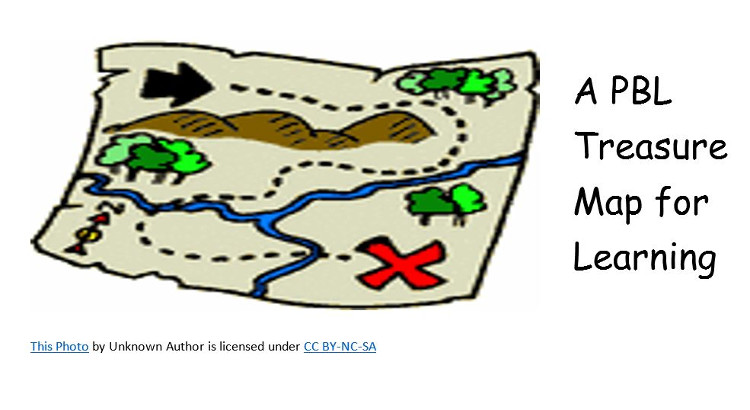Part 1: Ten Reasons for Mapping Out PBL… Scaffolds That Makes Project Based Learning Work


By now you know that I really believe in the power of PBL. It supports tested content standards and important 21st century skills while PBL providing teachers with the why and how. In this series I wish to investigate that “why” and “how” while providing some ideas and resources to support PBL planning.
As I travel the country I have so many teachers ask me what PBL really looks like. We analyze videos together, visit successful classrooms, and read case studies. While this satisfies part of their need I still have educators asking what does PBL look like. With some conversation it soon comes down to, what does PBL planning look like?
This is a great question to be asked because teachers can see that in many ways PBL allows for needed transformation, but also incorporates so much of what they may already do. Another question I am also asked is how a project can teach difficult standard? The answer… the project is the mechanism that the teachers uses to facilitate learning of standards. This may even involve an “explain session” by the teacher either through traditional means, or possibly a flip video, in or out, of classroom scenario. The next question usually is in regards to wanting to know how a project assesses the standards. The answer once again is through traditional means as a test, performance-based observation, ongoing formative assessment, or a combination of all. The teacher still provides assessment, but also incorporates student and peer assessment along with community (virtual or real) possibilities. Self-assessment is many times the most powerful.
Let’s go back to the question of how a PBL is planned. Of course, standards must be at the foundation. It might be that the teacher designs a project around standards, or it might be that the project comes first, and the teacher builds an integration to the standards. Both work, although some of the best will include a local community possibility, allowing for authenticity that incorporate the standards. Either way a question is the basis for inquiry and the question(s) will uncover the standards. Some of this will be addressed in a later blog.
[15 Ideas to Ensure That Project Based Learning is Grounded in Content And Standards]
As we talk about mapping or the scaffold of a project we refer to the design process of making a PBL. A PBL is made up of products. Take for instance a video student will make. We all know that the end-product is the video. Let’s examine what other products it took to get there. Perhaps there was an outline.. Students must be taught how to outline. There might also be a product of providing a narrative, or writing a journal, or examining details. There might be science content that must be researched which is another product, or a persuasive essay that will be the basis for the video. The persuasive essays might be an individual product that leads to a group video product.
Think of all the products I just mentioned. What lessons are needed for each product? Perhaps a lab, web quest, simulation, lecture, inquiry, video, guest speaker. All these lessons are mapped out under each product. Keep in mind these are lessons that may have always been done in the classroom. We do not always invent something new, we can incorporate the old in the product. Keep in mind that there must be assessments in the products. Some might be traditional, such as a quiz, while others might be performance-based, or even student self-reflection using an exit ticket.
Tools and ideas to transform education. Sign up below.
The Product Map might look like what I have below. The teacher must think what lessons/activities and standards must be provided to make the learning come alive for students.
One Product for a PBL Video (Keep in mind that this video will have multiple products. Others might in a persuasive essay, another research on a content subject, still another the outline as I spell out below)
Example: (): (Keep in mind that standards, lesson/activities, and assessment must be aligned.
Standards (All of those outline standards that must be taught… list them on your map)
ELA001 Determining main ideas for an outline, ELA002 Supporting main ideas with details ELA003, Comparing phrses and sentences, ELA004 Proper sequencing of ideas, ELA005 Writing an outline, ELA006 Critiquing and revising techniques, ELA007 Connecting an outline to a written product
Lessons: (All those lessons and activities that must be incorporated… list them on your map)
Examination of final writing and outline , reading an outline, video on main ideas and supporting details, practice lesson on main idea and supporting details, collaborative outline writing lab, collaborative writing of outline from persuasive paper for video.
Assessment: (All those lessons and activities that must be incorporated… list them on your map)
Journal entries exit tickets, outline explanation, peer critique, teacher critique, even a basic quiz, and of course summative assessment of the final product.
This might be . Think of the other products you will want to map out for the PBL. When we put all these product maps together we have a Project (PBL). They may include persuasive essay, research on a content subject, and even a product that covers prose to scripts and storyboards.
Keep in mind there is not one product grade or assessment. There are quite a few that will keep the student focused and on track. There are also a wide variety of means to facilitate the standards, including a lecture… although I believe most lectures should come after exploration and inquiry (Explain… part of 5E process). The students, through teacher guidance, may even be able to give it. As the mapping continues and is completed the teacher then takes all the products, lessons/activities, and assessments and will put them on a calendar.
In the next post I will share ten reasons why mapping in PBL is so important and several template ideas you can use based on the scaffold/mapping process I have described. I do hope you can see that thinking through the PBL with some mapping of ideas will ensure that real learning and authentic purpose are accomplished. While the students are owning the learning at the center, the teacher is involved with intentional planning at the start, effective facilitation from the side, and a shared and constant assessment through-out. These ideas provide that background look of what PBL really looks like! Be sure to gain more insight as you join me in part two of this post coming next and I hope you enjoy this PBL journey and treasure the idea of mapping!
Thank you for joining me and I hope you found this information something you can use in your school and useful to share with other educators. As always, I invite you to follow me on twitter (mjgormans). Please give this post a retweet and pass it on to someone who will benefit. To ensure you do not miss a future valuable post or other resource covering PBL, Digital Curriculum, STEM, 21st-century learning, and technology integration please sign up for 21centuryedtech by email or RSS. Have a great week! – Mike (https://21centuryedtech.wordpress.com/
cross-posted at 21centuryedtech.wordpress.com
Michael Gorman oversees one-to-one laptop programs and digital professional development for Southwest Allen County Schools near Fort Wayne, Indiana. He is a consultant for Discovery Education, ISTE, My Big Campus, and November Learning and is on the National Faculty for The Buck Institute for Education. His awards include district Teacher of the Year, Indiana STEM Educator of the Year and Microsoft’s 365 Global Education Hero. Read more at 21centuryedtech.wordpress.com.
